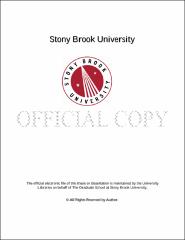| dc.identifier.uri | http://hdl.handle.net/11401/76746 | |
| dc.description.sponsorship | This work is sponsored by the Stony Brook University Graduate School in compliance with the requirements for completion of degree. | en_US |
| dc.format | Monograph | |
| dc.format.medium | Electronic Resource | en_US |
| dc.language.iso | en_US | |
| dc.publisher | The Graduate School, Stony Brook University: Stony Brook, NY. | |
| dc.type | Dissertation | |
| dcterms.abstract | Cell membranes are a complex mixture often composed of approximately equal parts lipid and protein molecules. Lipids are amphipathic, having polar headgroups that prefer to associate with water and hydrophobic tails that self-associate away from water. As a result, the lipids in cell membranes exist in the form of a lipid bilayer, with lipid polar headgroups facing outwards towards water and tails grouped together in the middle. Proteins embedded in this bilayer facilitate the movement of molecules across this barrier. The molecules that form the membrane have an asymmetric distribution, with different lipids being preferentially found on one side of the bilayer or the other and membrane proteins having a definite, defined orientation. In this work, we investigated how lipid and protein structure either assist or hinder their movement across the lipid bilayer. Using simple peptides as models for proteins, we have shown that peptides accelerate the transleaflet movement (flip-flop) of lipids across the lipid bilayer in a time- and sequence-dependent manner. We also investigated the effect of polar amino acid residues located in the membrane, and the effect of different types of lipids of the rate of flip-flop. In a second study, we investigated what polar sequences at the ends of hydrophobic peptides were able allow the peptide to move across membranes, or retarded such movements. We found that peptides with relatively large and polar sequences attached at their ends were able to pass through a biologically relevant membrane rapidly, i.e. in less than 10 sec. The amount of cholesterol limited peptide movement across the bilayer, but even then only at a detectable level for the peptide with the longest, and most polar end sequence. These results have implications membrane protein maturation, and mode of membrane penetration for certain toxins, and for control of protein and lipid localization in our new asymmetric membrane preparations, which mimic cell membranes more closely than prior artificial membranes. | |
| dcterms.available | 2017-09-20T16:51:06Z | |
| dcterms.contributor | Bowen, Mark | en_US |
| dcterms.contributor | London, Erwin | en_US |
| dcterms.contributor | Scarlata, Suzanne | en_US |
| dcterms.contributor | Thanassi, David. | en_US |
| dcterms.creator | LeBarron, Jamie | |
| dcterms.dateAccepted | 2017-09-20T16:51:06Z | |
| dcterms.dateSubmitted | 2017-09-20T16:51:06Z | |
| dcterms.description | Department of Physiology and Biophysics | en_US |
| dcterms.extent | 114 pg. | en_US |
| dcterms.format | Application/PDF | en_US |
| dcterms.format | Monograph | |
| dcterms.identifier | http://hdl.handle.net/11401/76746 | |
| dcterms.issued | 2016-12-01 | |
| dcterms.language | en_US | |
| dcterms.provenance | Made available in DSpace on 2017-09-20T16:51:06Z (GMT). No. of bitstreams: 1
LeBarron_grad.sunysb_0771E_13072.pdf: 2639903 bytes, checksum: f82ebd84423ea4a741890a1f4f07c627 (MD5)
Previous issue date: 1 | en |
| dcterms.publisher | The Graduate School, Stony Brook University: Stony Brook, NY. | |
| dcterms.subject | Biophysics -- Biomedical engineering -- Molecular biology | |
| dcterms.subject | flip-flop, insertion, juxtamembrane, lipid asymmetry, TM/non-TM interconversion, transmembrane peptide | |
| dcterms.title | Transverse Movements of the Components of the Lipid Bilayer | |
| dcterms.type | Dissertation | |

